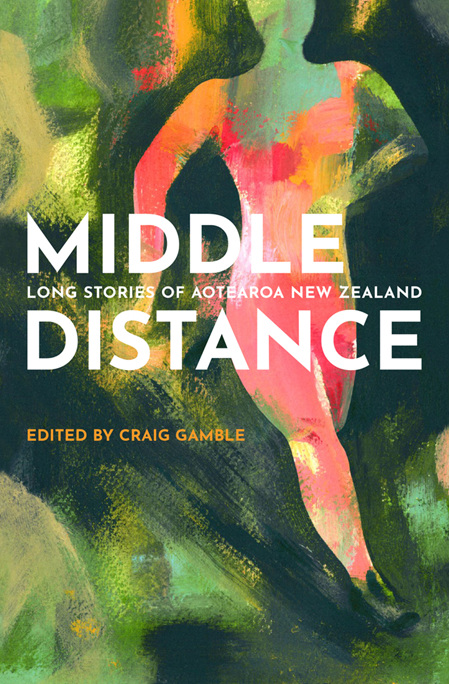
Middle Distance: Long Stories of Aotearoa New Zealand is a recent anthology of stories around 10,000 words each, shorter than a novella but longer than the typical short story. For me, these long stories (novelettes?) were a nice change of pace, with enough meat on their bones to be satisfying, while not requiring the time commitment of a longer novel or novella. Published by Victoria University Press, the book contains fourteen new stories by New Zealand writers, covering a range of styles and genres. Most, but not all, are set in New Zealand, with a very Kiwi flavour. Ordinary family problems are a recurring theme, but some stories delve into other-world fantasy and horror. There’s something here for everyone. The stories are:
Scales, Tails, and Hagfish by Octavia Cade: A pre-teen girl with scaly eczema claims to be a mermaid. Her continued insistence antagonises people and gets her into trouble as she engages in increasingly bizarre activities to prove her point—activities that eventually land her in hospital after an encounter with an angry seal—but her mermaid dreams may not be entirely delusional.
School Spirit by Joy Holley: A ghost story, with several graduates returning to their old school after dark.
The Promotion by Maria Samuela: Twenty years apart, a father and his abandoned son come to Wellington from the Cook Islands looking for work, and experience similar cases of culture shock.
Basil and the Wild by Rem Wigmore: A fairy tale of sorts, and I love fairy tales. Two outsiders—a slow-witted shepherd and a forest giant—become friends, but the frightened villagers are unable to see past the giant’s threatening bulk, or understand the shepherd’s attempts to protect his peaceful friend.
Getaway by Nicole Phillipson: Unlike the previous story, this is grounded in current reality, showing us a dysfunctional family whose members are unable to communicate with each other or see past their own noses.
Backwaters by Emma Sidnam: A tale of Chinese immigrants to New Zealand in the 1870s. It starts out appearing to be a pleasant historical love story, but gradually morphs into something rather more unsettling.
The Dead City by Jack Barrow: This story is the most clearly fantasy, with nomadic tribespeople pursued by ghosts in a lush, jungly world. It includes evocative descriptions of an abandoned, haunted city, but I was not sure quite what was going on, and unfortunately I lost interest in trying to find out.
Ko tēnei, ko tēnā by Vincent O’Sullivan: A 19th-century bored, wealthy gentleman has tangled relationships with his sister-in-law and half-sister. He leaves England and travels to New Zealand, where he buys a tattooed head as a macabre souvenir. On his return to England, he gets drunk and shows the head to the two women. It isn’t clear where the story is going, or how the two women feel about him, until the very end, where they deal out what is a clear instance of poetic justice.
Ringawera by J. Wiremu Kane: Culture clashes again, along with a bit of a mystery involving several people attending a Māori funeral. One woman is intent on giving her deceased aunt the proper ceremonial farewell she wasn’t allowed to give her late Pākehā wife. Two others—both young gay men, one a cop—struggle to fit in with the other Māori. For me, this was the outstanding story in this collection, with universal emotional arcs around otherness and acceptance.
Around the Fire by Anthony Lapwood: A father of three, struggling to keep his family together after his wife leaves, reflects on an incident in his own childhood: his father, divorced from his mother, took him and brother on an unauthorised, two-week long, incommunicado “camping trip”.
Afterimages by Sam Keenan: Set in the World War II era, a woman draws on theories about recently-discovered dark matter to escape painful reality by disappearing—literally, as in becoming invisible.
Like and Pray by Samantha Lane Murphy: A young couple’s daughter dies suddenly. The father, confronting reality, wants to grieve silently, but the mother, a member of some charismatic evangelical cult, is sucked into an ecstatic worship service attempting to call the girl back to life.
Sea Legend by Kathryn van Beek: This is a different sort of mermaid story. A fishing trawler pulls a mermaid up in its net, forcing the newest member of the crew into a crisis of conscience.
The Black Betty Tapes by David Geary: This is speculative fiction and the most adventurous story, told in a fast-paced—and rather baffling—series of transcripts of interviews with people involved in the future Queen Elizabeth III’s ascension.
As with any anthology, the stories are not equally successful. Besides Ringawera, the ones that left the biggest impression on me, either because I enjoyed them or they stuck in my head afterwards, were Backwaters, Ko tēnei, ko tēnā, Basil and the Wild, and Scales, Tails, and Hagfish. There’s a lot to like here; other readers may have different favourites.
